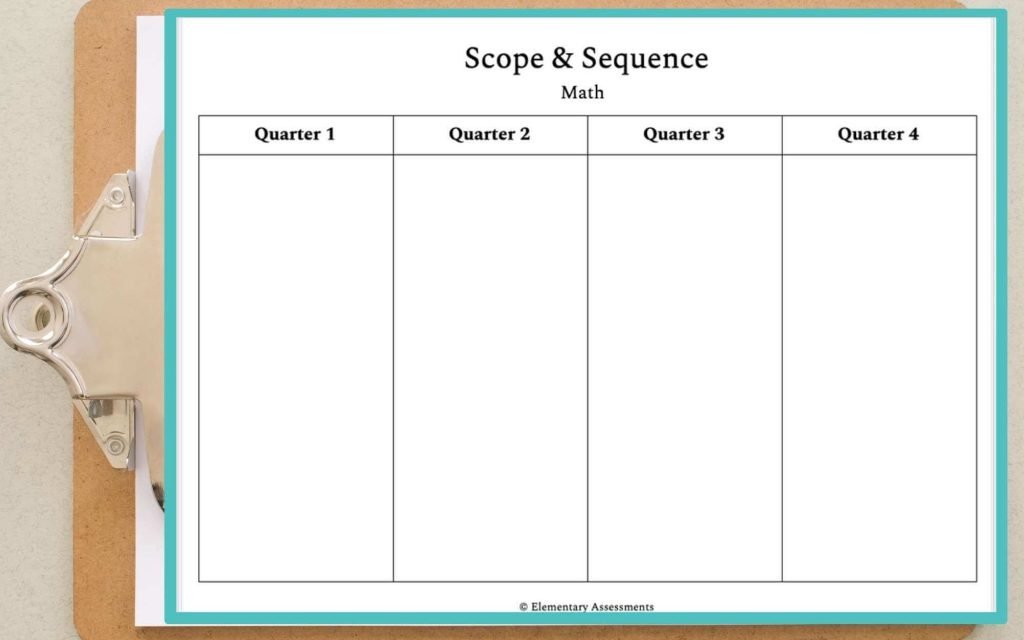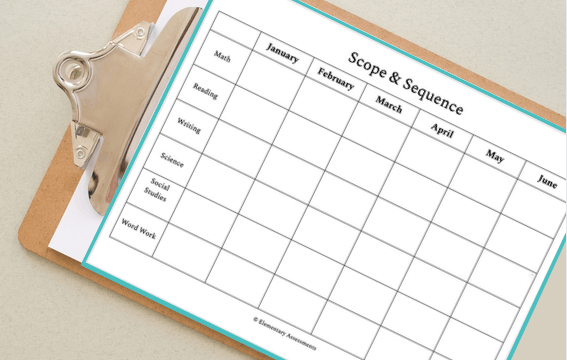Use the following simple-to-use blank scope and sequence templates to plan your teaching.
A scope and sequence template (also known as a pacing guide template) provides a framework for structuring a school’s curriculum into time-based segments, with the goal that students learn teaching objectives in a strategic sequence.
While your school district may have a particular scope and sequence pacing guide in place for teachers to utilize, it’s quite easy and a great idea to create your own simplified version.
Doing so provides you with a clear and concise teaching plan for the entire school year that serves as a helpful reference when lesson planning.
In this post, you’ll…
- View simple yet effective blank scope and sequence templates that you can use to plan curriculum.
- Discover the steps that show how to write a scope and sequence.
Blank Scope and Sequence Templates
Though blank scope and sequence templates come in a variety of formats, the following examples focus on templates that organize data by quarter and month.
12-Month Blank Scope and Sequence Template
This first scope and sequence template works well for elementary teachers.
It organizes curriculum data monthly and includes all 12 months. Subjects include math, reading, writing, science, social studies, and word work.
This blank scope and sequence template is also ideal for teachers who want a very concise pacing guide with few details.
Once you download this pacing guide template, you’ll be able to edit each blank cell with your own information.
Log into your Google account so that you can make a copy of the editable 12-month scope and sequence template.
Four-Column Pacing Guide Template
Though similar to the 12-month blank scope and sequence template, this blank scope and sequence template organizes data quarterly.

It can be customized by typing your district’s curriculum information into each cell.
Plus, it provides sufficient space to write detailed curriculum information.
Log into your Google account so that you can make a copy of the four-column scope and sequence template.
Quarterly Scope and Sequence Template With Subject Areas

If you desire a quarterly structure that’s more concise, use the following scope and sequence version.
It is divided into four quarters but has class subjects labeled on it.
Log into your Google account to make a copy of the quarterly scope and sequence template with subjects.
Bird’s Eye View Scope and Sequence

This scope and sequence template is divided into quarters and provides a bird’s eye view of the entire school year.
It’s great for note-taking the major units, themes, or topics that students will be expected to cover each quarter.
On the downloadable templates, you can edit to add your own information including dates.
There is also a page with pre-written months that you may want to use instead.
Log into your Google account in order to make a copy of the bird’s eye view scope and sequence template.
Monthly Scope and Sequence Calendar
For teachers who want to explore one month’s worth of lessons and activities at a time, this is the template to use.

Though it is not editable, you can print a ready-to-use copy. It includes space for the month, space for calendar dates, and space to write topics.
There is also a notes section plus an area to write the three biggest objectives you need to cover with students within the month.
Download a copy of the monthly scope and sequence calendar.
Blank Scope and Sequence Templates: Q & A
How do I write a scope and sequence?
Here’s the process to write a scope and sequence.
- Decide if you’ll organize your curriculum data monthly or quarterly.
- Choose which subject you’ll dive into first. (e.g. math, reading, writing, etc.)
- Grab a list of all the learning objectives/units you’ll need to teach for the entire school year. Your state standards (Common Core, TEKS, etc.) provide a good base.
- Brainstorm the best order to teach the learning objectives.
- Strategically allot specific teaching objectives for each month or quarter.
- Preferably, review your work with colleagues to check for discrepancies, inconsistencies, and/or misplacements.
When drafting a scope and sequence, you can make it as concise or detailed as you like.
What’s an example of a scope and sequence?
Following is an example of an elementary scope and sequence.
Subject/Grade: Math (3rd Grade)
Format: Quarterly
The pacing guide example below only shows the titles of the math units.
However, depending on your needs, you may need to add underneath each unit’s name the Common Core numerical codes, Texas TEKS numerical codes, or whichever state standard codes your district uses.
| 1st Quarter | 2nd Quarter | 3rd Quarter | 4th Quarter |
| Unit 1: Introducing/Implementing Calendar Math Unit 2: Place Value Unit 3: Computation with Whole Numbers (Addition/Subtraction) | Unit 4: Computation with Whole Numbers (Multiplication) Unit 5: Money Unit 6: Graphs/Patterns & Data | Unit 7: Geometry Unit 8: Fractions Unit 9: Probability & Measurement | Unit 10: Adding & Subtracting Fractions Unit 11: Time & Temperature Unit 12: Perimeter/Area |
For best results, at least once during the school year, make time to vertically align (plan curriculum content across grade levels) grade level scope and sequences.
See this example of an elementary school’s language arts vertical alignment scope and sequence.
Final Thoughts
Using these pacing guide templates, you’ll be able to strategically organize curriculum standards, guaranteeing that you cover all learning objectives by the end of the school year.
For best results, at the beginning of the school year, dedicate a few days or weeks to filling in your editable, blank scope and sequence templates.
Doing so will allow you to confidently refer to them when planning and when meeting with your teaching team during the school year.

